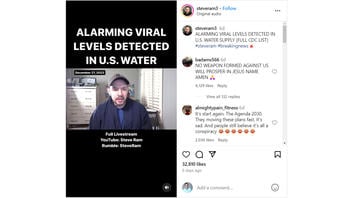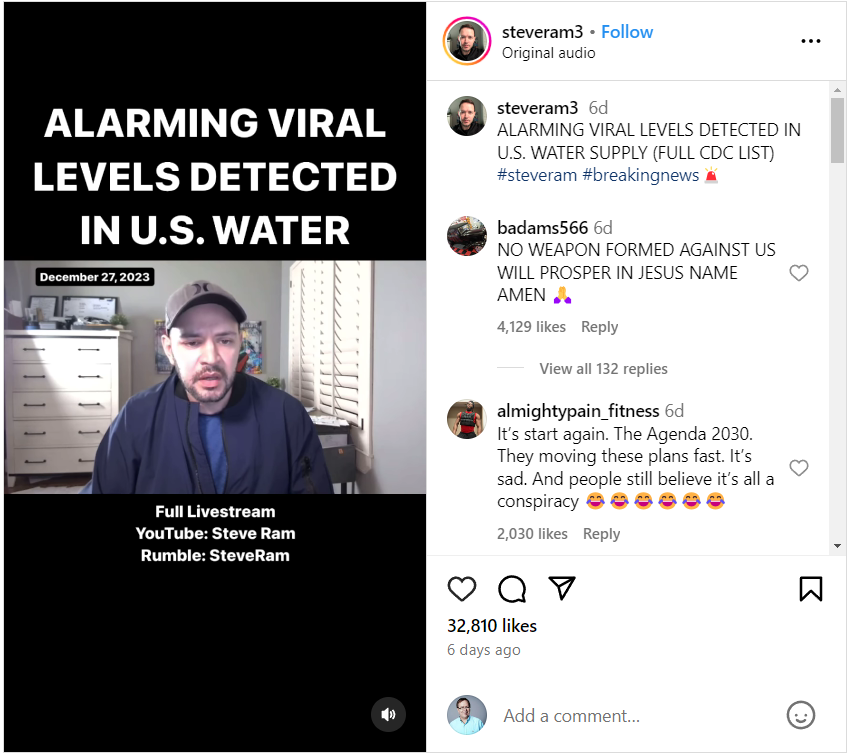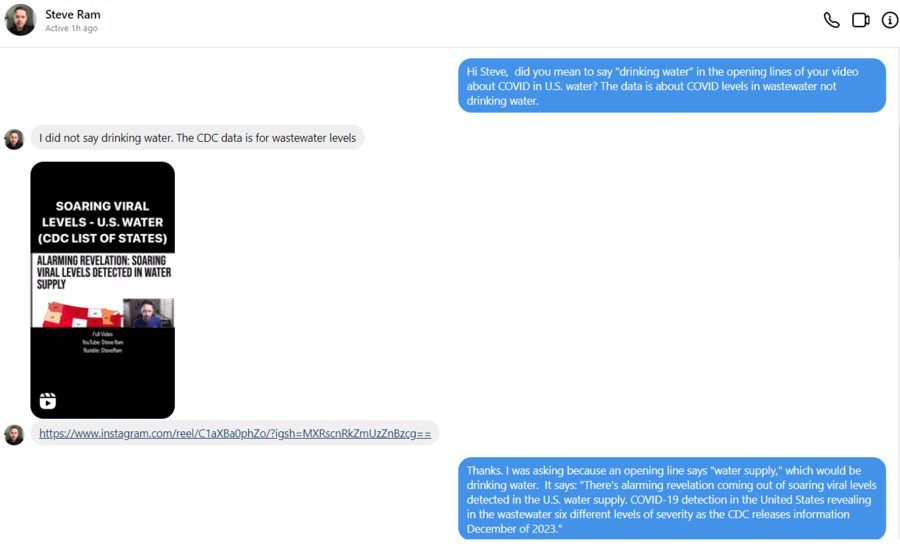Fact Check: CDC Did NOT Detect ‘Alarming Viral Levels’ Of COVID-19 In US Water Supply — It Was In Wastewater

Did the Centers for Disease Control and Prevention detect “alarming viral levels” of COVID-19 in the U.S. water supply? No, that’s not true: The CDC told Lead Stories that there’s no evidence to suggest that people can get the virus through tap water. The CDC data used to make the claim refers to “viral activity” in wastewater or sewage, not tap water, so it wouldn’t be part of the water supply.
The claim appeared in a post and video (archived here) published on Instagram by steveram3 on December 27, 2023, under the title “ALARMING VIRAL LEVELS DETECTED IN U.S. WATER.” The post’s caption said:
ALARMING VIRAL LEVELS DETECTED IN U.S. WATER SUPPLY (FULL CDC LIST) #steveram #breakingnews🚨
This is what the post looked like on Instagram at the time of writing:
(Source: Instagram screenshot taken on Wed Jan 3 17:49:47 2024 UTC)
The video
The opening lines of the 90-second clip echo and expand upon the text of the post. In it, Steve Ram, who identifies himself as a real estate investor, YouTuber and entrepreneur, lays out the basis of his claim. He says:
There’s alarming revelation coming out of soaring viral levels detected in the U.S. water supply. COVID-19 detection in the United States revealing in the wastewater six different levels of severity as the CDC releases information December of 2023.
Ram appears to equate the “U.S. water supply” with the Centers for Disease Control and Prevention’s (CDC’s) data on “viral activity” in wastewater in his video, but the two are not the same thing. The water supply is typically known as drinking water or tap water and must meet certain quality requirements, while wastewater is also commonly known as sewage.
National Wastewater Surveillance System
In the full-length podcast (archived here) that the video clip comes from, Ram said he pulled his data from the CDC’s National Wastewater Surveillance System, which tests wastewater and can help find signs of infectious diseases in a community, even when people don’t show symptoms. This data gives an early heads-up about whether infections might be going up or down in an area.
Centers for Disease Control and Prevention
Thomas Skinner, a public affairs officer with the CDC, addressed the claim in a January 3, 2024, phone interview with Lead Stories. He said Ram “may be confusing” water supply with wastewater:
COVID is not spread through drinking water. There’s no evidence to suggest that people can get COVID-19 by drinking water, and in fact, that hasn’t been detected in drinking water.
Bottom line: High levels of COVID-19 in wastewater don’t translate to high levels of COVID in treated drinking water. Skinner added:
Conventional water treatment methods that are used that use filtration, disinfection and those that are found in municipal drinking water systems should remove or kill the virus that causes COVID-19. …
We certainly don’t want to imply through information that we’re putting out about the [National] Wastewater Surveillance System … that there’s a risk of him getting COVID from drinking water. Because there’s not.
Public systems treat wastewater before releasing it into local waterways. Additionally, public water systems also treat water for drinking.
Lead Stories (LS) reached out to Ram through social media and email and got this direct message response via Instagram on January 3, 2023. It said:
LS: Hi Steve, did you mean to say ‘drinking water’ in the opening lines of your video about COVID in U.S. water? The data is about COVID levels in wastewater not drinking water.
Ram: I did not say drinking water. The CDC data is for wastewater levels [Ram included a linkto another post covering similar material]
LS: Thanks. I was asking because an opening line says ‘water supply,’ which would be drinking water. It says: ‘There’s alarming revelation coming out of soaring viral levels detected in the U.S. water supply. COVID-19 detection in the United States revealing in the wastewater six different levels of severity as the CDC releases information December of 2023.’
A screenshot of the conversation appears below:
(Source: Instagram screenshot taken on Wed Jan 3 22:57:25 2024 UTC)
Ram did not respond to additional questions asking him to clarify his comments.
Read more
Other Lead Stories fact checks about COVID-19 can be found here.
This article has been archived for your research. The original version from Lead Stories can be found here.




